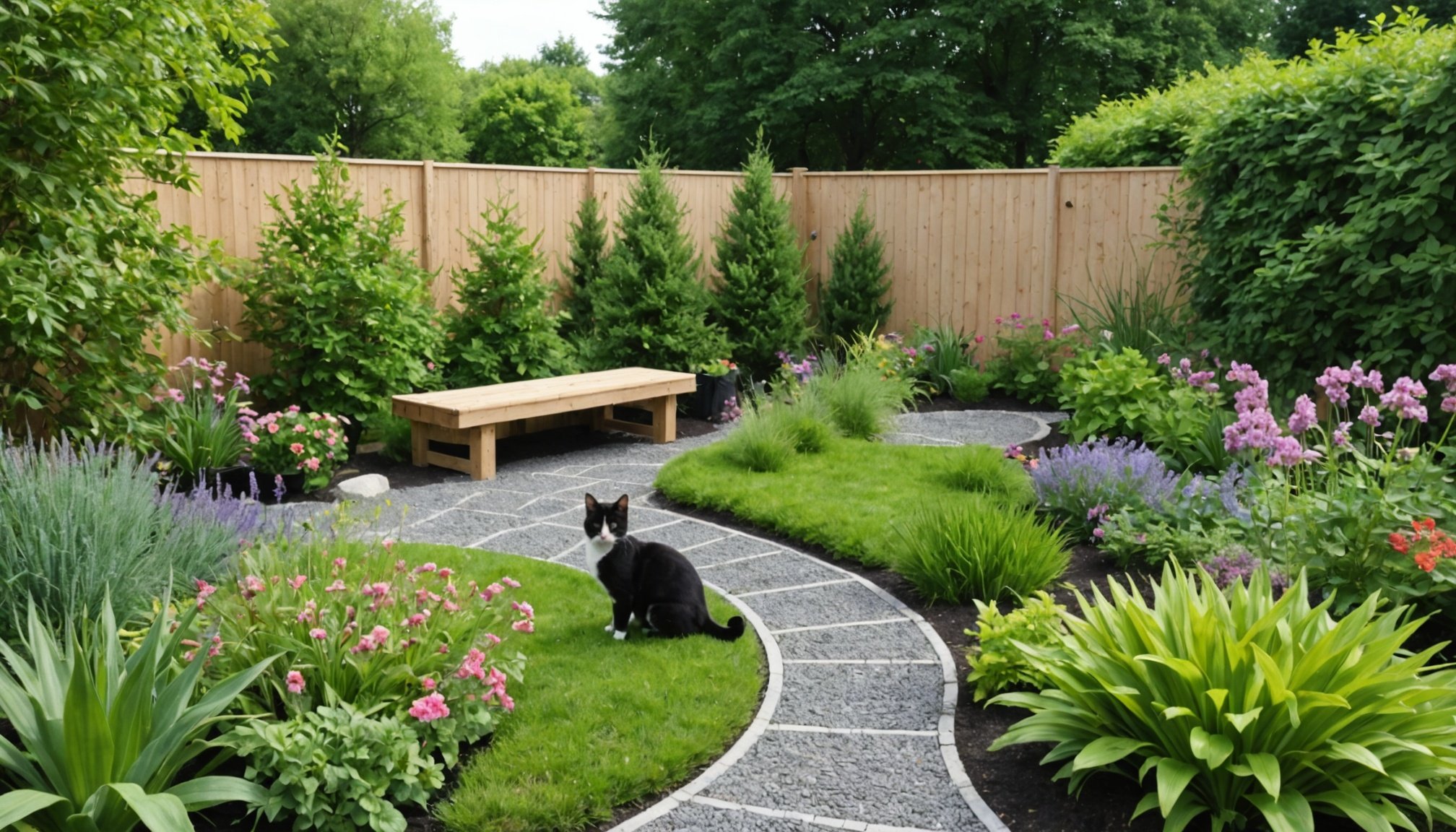Understanding the Needs of Blind Cats
Blind cats have unique sensory needs that require special attention. Understanding their specific requirements is crucial for ensuring their well-being. Unlike sighted cats, blind cats rely heavily on their remaining senses, namely smell, touch, and hearing, to interact with their environment.
Sensory Limitations and Adaptations
Blind cats face sensory limitations that can affect their behavior. For instance, they may have difficulty navigating unfamiliar spaces or locating food. Such challenges underscore the importance of enhancing their other senses. These cats often develop heightened sensitivity in their sense of smell and hearing to compensate for their lack of vision. This adaptation allows them to recognize familiar people, places, and objects.
Avez-vous vu cela : Effective Strategies for Controlling Your Cat”s Diet and Preventing Obesity
Creating a Sensory Garden
One effective way to cater to the sensory needs of cats is to create a sensory garden. This garden can incorporate various elements to stimulate their senses safely. For instance, using plants that emit strong scents like mint or lavender can help improve a blind cat’s sense of smell. Textured surfaces and objects can engage their sense of touch, while auditory cues such as wind chimes can aid in orientation.
These adaptations and thoughtful enhancements can significantly improve the quality of life for blind cats, offering them a rich and engaging environment to live in.
Lire également : Essential Tips for Assisting Your Cat in Healing from Trauma
Designing a Safe Space
Creating a secure outdoor environment is essential for blind cats to explore confidently. The primary goal is to ensure safety in garden design by incorporating specific features tailored to their needs.
Firstly, using barriers and fencing is crucial. These structures prevent cats from wandering into potentially dangerous areas, whilst also providing them with a safe, delineated space within which they can roam freely. A garden fence that is high enough to deter escapes, yet constructed to avoid sharp edges or gaps, will greatly contribute to blind cat garden safety.
The layout of the garden should also be carefully considered. Pathways and borders should be made distinct, perhaps through varying textures, to help blind cats navigate the area without visual cues. Secure layouts mean reducing clutter and arranging furniture or larger items in a predictable pattern, which can prevent accidents.
Be wary of hazardous plants and materials that could pose risks. Some plants might be toxic if ingested, while others could cause injuries. Therefore, maintaining a clean and clutter-free garden is crucial in creating a secure outdoor environment. Additionally, ensure there are no small objects that could be swallowed or toxic substances within reach. A thoughtful approach enhances both safety and the enjoyment of the space for blind cats.
Selecting Cat-Friendly Plants
When selecting cat-safe plants, it’s important to consider options that won’t just beautify your home but will also provide a stimulating environment for your feline friends. Certain non-toxic plants can be delightful for cats, engaging their senses of smell and touch.
Sensory plants for cats such as cat grass and silvervine are ideal choices, as they are safe to chew and can boost indoor enrichment. Aromatic plants like catnip and valerian offer appealing scents that can entertain your pet. These aromatic plants emit scents known to excite and comfort cats.
Incorporate a variety of textures with options like Boston fern, which has delicate leaves that can intrigue curious paws. Spider plants are also cat-friendly and add an elegant draping look. Including different textures and aromas makes for a well-rounded plant selection.
For year-round enjoyment, consider seasonal flowers that align with different times of the year. African violets are a safe blooming choice, offering vibrant colours without posing a risk. Remember, seasonal flowers can bring diversity and freshness to your home continuously.
Selecting the right plants ensures that your cats remain safe and engaged, turning your living space into a haven of natural curiosity and delight.
Creating Engaging Pathways and Textures
Designing sensory pathways in your garden can transform it into a delightful experience for your cat, especially for those who are blind. Interactive garden design focuses on making the environment engaging and safe. Incorporating diverse textures underfoot encourages exploration by appealing to your cat’s heightened senses.
When envisioning cat-friendly pathways, think about how different materials can create unique tactile experiences. For example, smooth pebbles and soft grasses make excellent choices. These elements add a playful yet safe dimension, enticing your cat to wander while ensuring comfortable footing. This is particularly beneficial for blind cats who rely heavily on their sense of touch.
Consider using alternating textures to mark zones. A shift from soft grass to a pebbled surface can signal a change in direction, aiding navigation. This not only enriches your cat’s sensory experience but also allows them to explore independently and confidently.
By incorporating these elements into your garden, you create a space that is safe for blind cats to explore, enriching their lives with new tactile elements that engage their senses. Transform your garden into a sanctuary where exploration and play go hand in hand.
Environmental Enrichment Strategies
Providing enrichment for blind cats requires creativity and understanding of their unique needs. Effective sensory stimulation for cats can significantly enhance their quality of life. One approach is to introduce water features and sound elements, which are engaging and intriguing. Running water can be both a soothing auditory cue and a tactile sensation that stimulates a blind cat’s curiosity, inviting them to explore their environment safely.
Adding climbing structures and hiding spots is another beneficial strategy. These elements create an opportunity for exploration and play, encouraging physical activity and cognitive stimulation. Climbing trees or shelves are great choices, as they help cats feel more secure by elevating them and providing various textures to engage with. Hidden areas act as safe retreats, giving blind cats a sense of autonomy over their territory.
Additionally, scent trails or scented toys can act as guides. These items stimulate a blind cat’s sense of smell, aiding navigation and providing mental engagement. An assortment of scents can lead them through different parts of their environment, creating a dynamic landscape full of surprises. Incorporating these strategies helps ensure a fulfilling, enriched life for blind felines, bridging the gap left by their lack of sight.
Layout Ideas for the Sensory Garden
Designing a sensory garden for blind cats requires thoughtful planning and specific considerations. Garden layout design should focus on creating safe, easily navigable spaces that cater to their unique needs. An effective layout involves dividing the garden into distinct areas meant for play, rest, and exploration. Each area should offer different textures, scents, and sounds to stimulate the senses and provide an enriching experience.
Accessible garden spaces should have clear pathways, marked by sensory cues like different ground materials—soft grass or gravel paths can guide your blind cat safely. Walls or low hedges can serve as gentle boundaries, indicating transitions between areas. These boundaries help prevent disorientation and enhance a cat’s confidence as they explore the garden.
When planning the blind cat garden layout, consider creating zones with distinct tactile features. Vertical structures, such as poles wrapped in fabric, provide climbing opportunities and set a clear contrast with open areas. Designated rest areas can include raised platforms with cosy blankets or heated mats. Always keep water and food in easily accessible spots, ensuring their independence.
Ultimately, this thoughtful design and garden layout can transform outdoor spaces into a secure haven that caters to the sensory reliance of blind cats, offering them a world full of exploration and comfort.
Visual Aids and Diagrams
Creating a sensorial garden requires careful planning and strategic plant placement to enhance sensory engagement. Garden design diagrams are crucial tools in this process, as they offer a pictorial representation of the intended layout, allowing gardeners to visualise elements before actual implementation.
Examples of Effective Garden Designs
Effective garden designs utilise clear diagrams to emplace tactical features such as aromatic plants, visually striking flowers, and textured paths. These elements, when placed correctly, can create an immersive experience. Sensory engagement is heightened through deliberate arrangements, facilitated by these visual aids.
Diagrams for Plant Placement and Layout
Diagrams illustrate strategic plant placement by highlighting locations that maximise interactions, natural lighting, and airflow. Including pathways, flyways, and rest spots integrates seamlessly into the whole design. This strategic planning ensures plants encourage sensory experiences.
Visual Representations of Pathways
Visual aids can depict pathways and tactile elements effectively by portraying variations in materials — like stones or gravel — that offer a unique experience underfoot. Incorporating such tactile components, along with contrasting colours and structures, enhances the sensory richness of the garden, making it both functional and captivating for cats and other participants in the green space.











